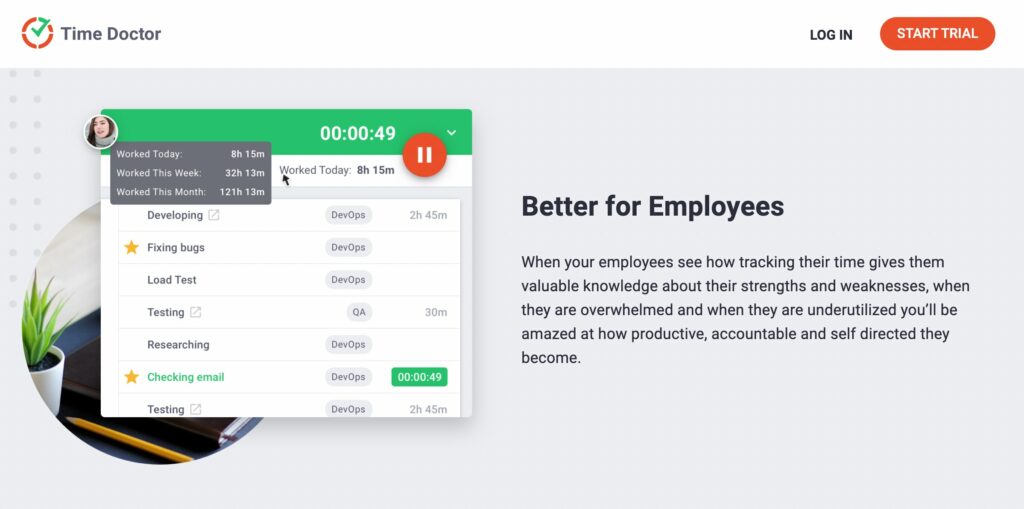Developed by Alan Lakein, an American author, the ABC method for time management is a simple yet effective way to improve your time and task management skills.
In the ABC method, you break down daily tasks by prioritizing them based on importance and urgency. This way, you can manage your time efficiently and get more done by prioritizing the right tasks.
In this article, we’ll explore the ABC analysis method and 12 ways to implement it in your life.
As a bonus, we’ll also discuss three other time management strategies you can use instead.
This Article Contains:
(Click on the links below to jump to a specific section)
- What is the ABC method for time management?
- 12 key ways to implement the ABC method of time management
- 1. Understand the importance of various tasks
- 2. Prioritize tasks and projects based on deadlines
- 3. Plan out every day
- 4. Estimate time required for each task
- 5. Set SMART goals
- 6. Allocate time and resources diligently
- 7. Use tech to measure employee performance
- 8. Limit employees from multitasking
- 9. Keep distractions away
- 10. Avoid overworking employees
- 11. Encourage employees to take breaks
- 12. Assess your team’s time management regularly
Let’s get started.
What is the ABC method for time management?
The ABC time management method involves categorizing your tasks into labels ‘A,’ ‘B,’ and ‘C’ — the letter A includes the highest priority and urgent tasks, while ‘C’ has the least important tasks.
Here’s a closer look at these labels:
- An A item or task is any work that has to be completed with the utmost urgency, such as projects with deadlines.
- Your B item is work that isn’t necessarily associated with a deadline but needs to be completed when possible. These can include tasks like archiving completed projects.
- Finally, the C item is the least important task in your schedule. Your C task is generally of little importance and should be completed when time is available.
Since your employees will typically have different times when they are most productive, it’s best to categorize more important tasks in relation to employees’ ‘golden hours.’
Note: the ABC method is sometimes called the ABCDE method as some tasks may not fit into just A, B, or C categories.
Now, let’s look at how you can implement the ABC time management method among your workforce.
12 key ways to implement the ABC method of time management
Good time management can help a company and its employees grow by improving workforce efficiency, especially if you run a small business.
So let’s look at the 12 best ways to utilize the ABC method of time management:
1. Understand the importance of various tasks
It’s essential to categorize your projects and tasks based on importance since different tasks may require varying amounts of time and resources.
These tasks can range from necessary business development to organizing an office get-together.
Understanding how each task is important can help you delegate tasks effectively, improve employee engagement, and provide consistent customer service.
2. Prioritize tasks and projects based on deadlines
When assigning projects, keep deadlines in mind, as last-minute assignments can lead to overworking.
If multiple projects are labeled as a B task, use numbers to prioritize them further. For example, if you have three B tasks, mark them as ‘B1,’ ‘B2,’ ‘B3.’ It means all the tasks are a priority, but in this case, ‘B1’ needs to be completed first.
3. Plan out every day
Daily plans for team members to understand what needs to be done and when. It’ll help keep your workflow organized and improve task efficiency.
A daily schedule can provide an overview of work that needs to get done in a day. Similarly, the to-do task list can help you track individual tasks.
In this schedule, add break reminders so employees can take a breather and come back refreshed. This will help employees maintain a healthy work routine and avoid burnout.
4. Estimate time required for each task
It’s essential to determine achievable time estimates for each project and task.
Wrong time estimates could negatively affect inter-team or client relations due to miscommunication and delays.
However, when dealing with new projects, it’s better to overestimate how long the first few tasks will take. This gives your team enough time to learn and understand the best way to approach these tasks.
Moreover, it can help you give clients more accurate time estimates going forward.
5. Set SMART goals
Here, you understand and categorize each task in the following format:
- Specific: Explain the goal in detail, providing your employees a clear picture of what needs to be accomplished and why.
- Measurable: Goals must be measurable in time, money, and resources. It’ll help you keep track of progress made and motivate your team.
- Achievable: Set achievable goals, but keep them challenging enough to push your team. This can boost employee engagement and productivity in the long run.
- Relevant: Ensure that tasks are relevant to overarching goals and delegate tasks to the right people for maximum resource utilization.
- Time-bound: Have clear deadlines and set priorities just for daily goals but also for long-term goals.
By following this method, SMART goals can be a great way to improve your team’s productivity and efficiency.
6. Allocate time and resources diligently
Make sure enough resources and time are allocated to employees according to project requirements.
If employees don’t have enough time or resources to complete their work, it can leave them feeling stressed and tired.
A good time management tip is to allocate 75% of your employees’ work time towards completing assigned tasks and leave 25% for any unexpected situations such as a medical emergency.
Employees will feel less burdened since they aren’t overloaded with work, positively affecting their overall productivity.
7. Use tech to measure employee performance
Keeping track of your employees’ productivity and work hours can help you understand the best ways to update your time management plan.
Let’s look at two software programs that can help you capture minute details about each employee’s performance.
A) Productivity tools
Tracking time can help employers understand where employees use their time and gain insights for improving their productivity.
But how do you accurately track employee work time?
Simple: using Time Doctor!

Time Doctor is a powerful time tracking tool that allows employers to monitor their employees’ working time.
It tracks your employees’ daily work activities and gives you detailed reports and real-time data to improve their time management.
Time Doctor also provides features and workday data, such as:
- Websites and apps accessed during work hours.
- Distraction alerts for employees
- Over 60 integrations with software like Asana, Jira, and Trello
You can also learn more about Time Doctor’s other helpful features.
B) Project management tools
Project management software programs like Trello or Zoho Projects create a virtual space for employers and employees to track project progress.
They also provide additional features, such as a Kanban board to visually depict progress and manage your inventory as well.
8. Limit employees from multitasking
Although multitasking is generally viewed positively in a work environment, it can negatively impact some employees.
When multitasking, the brain constantly switches between priorities, making employees less efficient and more susceptible to making mistakes.
Assign projects such that employees can focus their attention on a specific task and complete high-priority work without getting distracted.
9. Keep distractions away
Distractions at a workplace are generally unavoidable, but they can be mitigated.
It’s essential for employers to understand the main causes of distraction among employees and eliminate them as they can lead to procrastination.
Some activities, however, can be beneficial for employees to take a break.
For example, an activity like a quick mobile game during their break can help them recharge and get back to work. At the same time, an ongoing sports match could have employees constantly checking the score or highlights, which breaks their workflow.
Keep an eye on the various distractions that affect a workspace and make sure they don’t disrupt your employees’ productivity levels.
10. Avoid overworking employees
Poor time management and project planning usually lead to employees working overtime and tiring themselves out, burning them out in the process.
Employers can prevent this by paying close attention to their employees’ schedules and helping them manage their tasks more efficiently. Additionally, employers can approach their managers to understand why they might be stressed or anxious and seek solutions together.
For example, if an employee is struggling with urgent tasks during the early hours of the day, approach them to find out when they might feel energetic to take on the task.
11. Encourage employees to take breaks
Employees with a healthy work-life balance tend to be more productive and happier. Employers can promote this balance by encouraging employees to take regular breaks.
However, it’s essential that employees don’t take breaks too often; otherwise, it can become counterproductive.
If you have employees who have been working without leave for an extended time, suggest they take a vacation to recharge.
12. Assess your team’s time management regularly
Keep track of your time management plan and update it regularly in the following format to understand your team’s progress.
A) Daily
Spend around 15 minutes at the end of the day to review how your team has performed.
It’s important to keep critical tasks as a high priority and complete them at the earliest.
B) Weekly
At the end of each workweek, take some time out to study if there were any roadblocks and what you can do to improve next week’s performance.
Remember to look out for any work left undone and fit them into the following week’s schedule.
Additionally, while preparing the list of tasks for the following week, understand where your team could save time and resources to utilize them better.
C) Monthly
Ideally, at the end of the third week, assess your team’s progress and understand where they’ve improved or might require a push. It also gives you an additional week to iron out any issues before the start of the next month.
D) Yearly
When you enter the last quarter for the year, use all your past weekly and monthly assessments to track how your teams are getting things done.
Review your employees’ performances and identify areas that need improvement for the following year. Plan out the following year’s quarterly and yearly goals and repeat!
Although the ABC method of time management is a tried and tested method, there are other ways to manage your time effectively.

3 alternative time management strategies
Here are three alternate strategies for time management.
1. Eisenhower Matrix
The Eisenhower Matrix is an effective time management technique that divides work based on importance.
Tasks are divided into four quadrants to improve time management:
| Urgent | Not Urgent | |
| Important | Quadrant i Most important tasks to be completed within a deadline | Quadrant ii Important tasks, but can be scheduled for a later time. |
| Not Important | Quadrant iii Important tasks that can be delegated to another team member | Quadrant iv Unimportant tasks that may not contribute to the overall goal but would be nice to do |
Using this matrix, employers can quickly identify which tasks need immediate attention and which can be done later or eliminated altogether.
The Eisenhower method is beneficial for employees juggling multiple projects where it can be tricky to identify what’s important.
Additionally, this method can help with inventory management to understand what you need versus what you don’t.
2. ALPEN method
The ALPEN technique is a time management method system based on a set of principles. The letters are acronyms for German words that suggest how to manage time.
- Aufgaben or ‘A’ refers to your to-do list. It’s similar to an A task in the ABC method. These are your high priority tasks and need to be completed at the earliest.
- Länge or ‘L’ is the timeframe estimated for each task.
- Pufferzeiten or ‘P’ is the amount of time you use as a buffer for each task or project to ensure that employees can still meet deadlines in the event of an unexpected situation.
- Entscheidungen or ‘E’ is to establish priorities. Understand your important tasks and pull back or delegate to others when possible.
- Nachkontrolle or ‘N’ refers to recording and analyzing your weekly schedule based on the previous steps to understand how your teams can be even more productive.
Using this time management matrix, employees can complete their essential tasks when they are most productive and use their extra time to complete other tasks or take a break.
3. Pareto principle
The Pareto principle is sometimes referred to as the 80/20 rule, which states that 80% of results come from 20% effort for a lot of outcomes.
When combined with the ABC method of time management, the Pareto analysis can help improve productivity immensely.
Use the Pareto principle to prioritize your employees’ time on tasks that produce the best overall result. It can improve their productivity and teach them valuable time management skills.
Wrapping up
The ABC analysis can ensure your team is spending their work time on the most important things first.
Understand your employees’ strengths and tailor their ABC lists to take advantage of their productive work hours. You should also provide them with the right tools to effectively implement this time management technique.
We recommend using Time Doctor to keep updating your time management plans based on the ABC system. You can also check out these related articles to ensure your team grows consistently.
So sign up for Time Doctor’s free trial to get started today.

Vaishali Badgujar is a seasoned Content and SEO specialist who provides ROI-focused managed SEO services. She is dedicated to helping businesses connect with their audience online and see real growth through her work.


